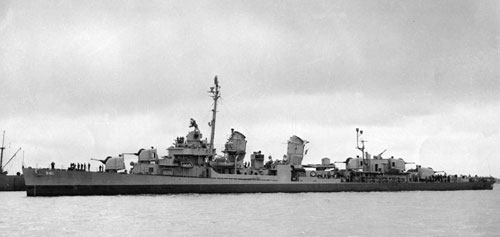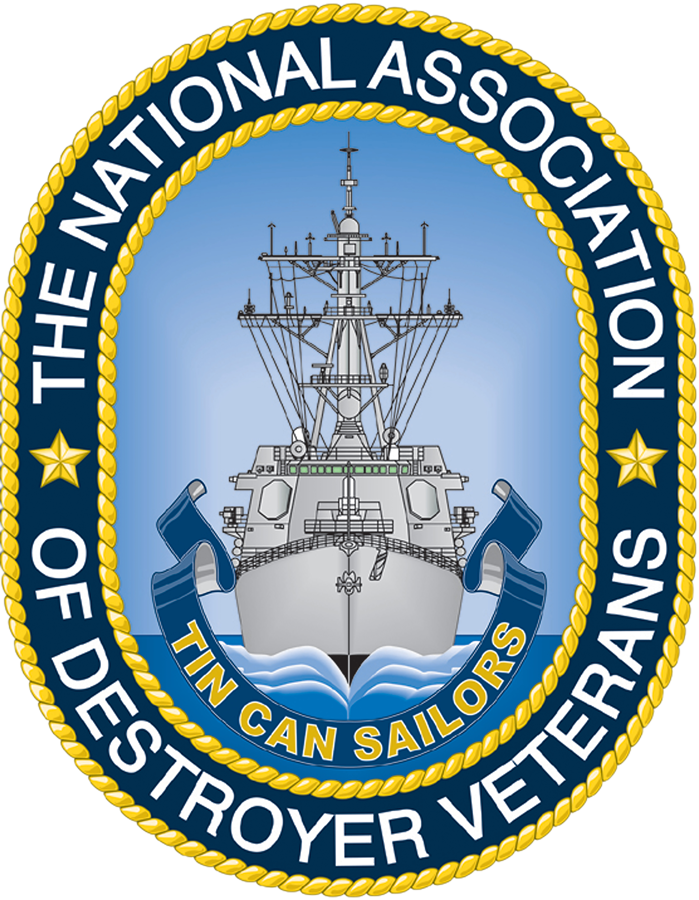A Tin Can Sailors Destroyer History
USS KIDD DD-661
The Tin Can Sailor, May 1987
Rear Admiral Isaac Campbell Kidd was killed in action on the bridge of his flagship during the Japanese attack on Pearl Harbor, December 7, 1941. He left a record of a brilliant naval career, and since destroyers are named for heroes, he left his name to a first line ship of the Navy. The name in itself was appropriate for a fighting ship because it smacked of pirates and all of the colorful fighting tales of the sea that young Americans love. That is why they called themselves the “Pirates of the Pacific” and why they had a picture of a pirate painted on the stack.
When she was new right after her commissioning at Brooklyn Navy Yard in New York on the 23rd of April 1943, she operated for a time as a member of task groups covering the North Atlantic Sea Lanes near Argentia, Newfoundland. They were eager and green in those days, and they fretted for the time when a German raider would make its appearance. But ships, like most everything else need a little time to mature and perhaps it is just as well that no excitement came from her tour of duty in the Atlantic.
The ship made her first acquaintance with big company in August when she was assigned to a group of large battleships, which went west through the Panama Canal and headed for Pearl Harbor and for the war. She learned how to take her place as a member of the screen for those large ships, to guard them from enemy sea and air and submarine attacks, and she even got a taste of battle damage control when one of the battleships, through error, fired two star-shells through her mid-section.
Her first action against the enemy, the carrier raid on Wake Island in October, proved poor hunting, but it gave the ship a taste of rescue duty of which she was to see much more. Many are the pilots who will tell you that the grandest sight they ever saw was the bow of the USS KIDD as it came over the horizon to their rescue after they had been downed in the Pacific.
Slowly the ship was growing up. Little by little she was coming to mean just a little more than a destroyer to the officers and men who manned her. “It’s a funny thing”, they would say, “but there is something about the old lady that gets under your skin.”
Middle October found the KIDD underway with a large group of battleships, carriers, cruisers and destroyers to deliver a strike on Rabaul and to support the Bougainville landing then taking place. The group arrived in the strike position south of Rabaul early on the morning of November 11, 1943. A strike was successfully carried out in the morning and another was being launched when reports of a large Japanese air attack were received. About this time, a plane taking off from the ESSEX crashed and the KIDD was directed to pick up the crew. As the ship reached the scope of the crash, which was by now eight miles astern of the formation, the first of the Jap planes, about twenty Vals, were sighted just before starting their dive, and for the first time the ship’s guns were fired in anger.
During the next fifty minutes, entirely on her own, the ship maneuvered near the scene of the crash, alternately conducting rescue operations, engaging enemy aircraft and dodging torpedoes. The men were picked up from the island and a total of eight enemy planes were engaged. Three of these were shot down in flames, another was probably destroyed, and hits were scored on several others. When, late in the day, the KIDD rejoined the formation, she arrived as a battle tested ship.
The KIDD was really in the war now. The pace was fast and the duty was varied. She screened the carriers that made the sustained air attacks on Tarawa during the invasion of the Gilberts. Once, when miles away from her formation investigating a submarine contact, she gave the warning of 15 low-flying enemy bombers that were headed toward the large ships. She shot down two of those same bombers and scored hits on others as they passed over.
She saw the invasions of the Marshalls first hand from the start, when she guarded the carriers that launched strikes against Roi, Wotjo, and Kwajaicin; through the actual invasion when she was the first ship to follow the minesweeper into the lagoon at Majuro; and to the finish when her group sortied from Majuro, and bombarded Wotjo daily. The KIDD was there and did her share of the bombardment and started her fair share of the fires.
She was a mature fighting ship now, and she had come to be a home for the men who rode her when she helped to guard Emirau Island until the airfield was completed and from there on to the landings on Aitape and Hollandia. Following these, she went on to the Saipan operation where she acted as a member of the screen for the escort carriers. There were plenty of enemy air attacks in those days, too, becoming really heavy during the battle of the Philippines Sea. The KIDD was on hand too, with the same escort carriers when they softened up Guam for invasion, later providing gunfire support for the actual landings. Once she went along to within 2,000 yards of the enemy coast to rescue a downed pilot.
Middle October 1944, found the ship doing duty with the Seventh Fleet enroute to Leyte Island and the invasion of the Philippines. She took part in the initial landings as a member of the screen and as a fire support ship.
Early in December, upon receipt of some long awaited orders, the ship returned to Mare Island Navy Yard for a major overhaul for her war-worn engines and a well-earned rest for her war-weary crew.
She sailed out again early in February 1945, but she had to hurry through the customary refresher training period at San Diego. She had to hurry because Task Group 58 was forming up for a try at the Japanese mainland and for the invasion of Okinawa. They needed first-line, battle-wise ships for the job and the KIDD took her place alongside, or rather right in front of the biggest of them.
She was some thirty miles out in front on the first morning of those daring strikes when she, and other ships of her squadron, formed a welcoming committee for the first Jap planes that came out to investigate the great armada that had the nerve to come so close to their shores. She was in front, too, on the second morning when she steamed in company with the USS BULLARD, to within eleven miles of the Jap mainland and her navigator took bearings on Japanese lighthouses. She stayed in front all during the first days of the Okinawa campaign when she screened the battleships that made the pre-invasion bombardments, and when she helped to guard the damaged FRANKLIN through the first night of her famous fight for survival. She fought off suicidal air attackers through the month of March, she rescued downed pilots, sank floating mines and, always, she gave early warning of impending raids to the big ships that were depending on her. It wasn’t until April 11th that she fell behind.
The raids that developed on that day weren’t out of the ordinary, even though four approaching formations of enemy planes were reported. The first three were dispensed with or driven off by the KIDD, her sister destroyers and the Combat Air Patrol. The fourth raid was reported to consist of only a single plane. He came in low over the water and even after he was hit he kept coming through everything that the KIDD could throw at him. However, her best efforts were not enough, and the suicider, a hero it is believed, crashed into the side of the ship. When the 500-pound bomb exploded, after passing through the forward fire room, it tore away metal clear to the top of the portside superstructure, the force of the explosion killing 38 men and wounding 55.
The enemy planes that were in the air off Okinawa that afternoon spotted the smoke from the fires and so they teamed up and tried to finish her off as she staggered back to join the main formation. They might have succeeded too, if they hadn’t been reckoning with a gang that called themselves “The Pirates of the Pacific.”
Somehow they managed to keep her afloat in spite of those holes in her side. They nursed her along under half her power and slowly they got her fires under control. While they were doing all this, they were caring for her wounded, and with many of her guns out of control they were firing everything but the ship’s compass, and so the only plane that got close enough to drop a bomb departed trailing smoke.
When they fought for her life that afternoon they didn’t know that the ship’s guns were being fired in anger for the last time in World War II. They didn’t know either that night when they fought to hold back the oil from her forward compartments or the next day when they joined up with their task force and buried their dead at sea, that for them their war was over. From there on to Ulithi for temporary repairs and to the West Coast of California, where they stayed until the war ended, the grade was all down hill.
The USS KIDD is now in museum status in Baton Rouge, LA.
TCS Supported Ship

